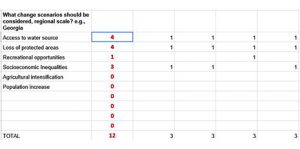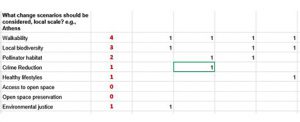Delphi Method with Google Docs
ALLISON EVANS, YANLI ZHAO, QIAO HE, PENGYU CHI, LESA MILLER
GLOBAL SCALE WITH TOP 3 PRIORITIES:
Conservation of forest lands
These conserved forest lands provides both active and passive recreation, scenic enjoyment, and a sense of well-being and community pride. They also provide relief from the densely confined aspects of the urban environment. Forests also have the richest biodiversity making it a primary habitat for many species. These forests also provide good carbon sequestration and absorption taking in harmful pollutants from the atmosphere. Thus, the conservation of forest land can keep the original biodiversity, which will reduce the negative impacts of land development. Forests also have the ability to hold stormwater runoff, which will keep the site away from flooding problems.
Link: http://blog.nature.org/conservancy/2010/12/04/top-ten-reasons-why-forests-matter/
Water Quality and Quantity
Water quantity and quality are fundamental for a good community garden in a global scale. Water can influence the quality of the product from the garden, since water washing off urban surfaces will carry all sorts of things with it, including metals, dirt, and debris. If this contaminated water is used for the garden, all those pollutants can make their way into the produce. Also, water provides ecosystem habitats, thus if water resources are damaged it will lose its value, and the commercial and recreational value of our water resources will also diminish.
Link: http://www.environment.nsw.gov.au/water/waterqual.htm
Importance of Biodiversity
By making sure that a variety of plant types are included in a community garden, not only does it attract a wider range of pollinators, but it also allows for better soil conditions that can increase nutrient content in the soil by planting different root type species. It also creates an opportunity for decomposing microorganisms to amend poor soils. It can also help in bringing in natural pest control to reduce the use of pesticides making for a cleaner environment.
Link: http://www.goveganic.net/article210.html
 REGIONAL SCALE WITH TOP 3 PRIORITIES:
REGIONAL SCALE WITH TOP 3 PRIORITIES:
Access to Water Sources
In order to create a productive community garden, access to water is imperative. A way to make sure that this issue is addressed would be looking into easy access from sources such as rivers, lakes, streams, and even utilizing rain barrels to provide for watering purposes. One last factor to consider is the importance of clean water that can be used for the garden.
Link: http://extension.uga.edu/publications/detail.cfm?number=C1027-11
Loss of Protected Areas
With rapid global population growth and continued development pressures, the commitment to establish protected areas is critical to not only to the present generation, but also to the future generations. Benefits of protected areas can be shown in conserving biological diversity including natural gene pools, maintaining ecological processes and the natural cycles required for life on earth, also acting as scientific benchmarks to evaluate environmental changes, and most importantly, balancing development needs in a sustainable society. Starting to take notice and make movements on protected areas now, can our future generations be able to experience, appreciate and enjoy nature, and to understand the ecological processes that all life depends on.
Link: http://worldparkscongress.org/about/what_are_protected_areas.html
Socioeconomic Inequalities
By looking at the difference in how communities are treated based on their race and/or financial standing, it can be seen how local governments often spend funds on the higher tax paying community and often times exclude the disadvantaged communities from their community improvement plans. Creating a community garden in a deprived neighborhood would not only help their economic standing by selling their own produce, they would also have access to fresh food which would increase food security for their neighborhood , and create a better connection among themselves as neighbors and the greater surrounding community.
Link: http://www.sciencedirect.com/science/article/pii/S0022318212811915
 LOCAL SCALE WITH TOP 3 PRIORITIES:
LOCAL SCALE WITH TOP 3 PRIORITIES:
Why Walkability is Important
Walkability is extremely important in urban areas. Living in a walkable neighborhood can increase one’s personal well-being and longevity of good health. Especially when urban areas are friendly to foot traffic and have a comprehensive public transportation system, people who can no longer drive or who are not interested in driving are not restricted and can escape the expensive costs that private transportation can incur.
Besides the health benefits, local community trust can be gained in a walkable environment, thus it decreases crime rates and even increases economic activity. Athens Downtown, as an example, is a pedestrian oriented community that is highly walkable. Residents and university students like to walk to places such as corner markets, restaurants, public parks and other necessary establishment for life. During those activities, better communication and interaction could be built up between people.
Link: http://www.myathensblog.com/walkability/
Local Biodiversity
Biodiversity boosts local ecosystem productivity where each species, no matter how small, all have an important role to play. For example, a larger number of native plant species means a greater variety of crops, and greater species diversity ensures natural sustainability for all life forms. Furthermore, healthy local ecosystems can better withstand and recover from a variety of disasters. So, while we dominate this plan this planet, we still need to preserve the local diversity in wildlife.
Link: http://www.nwf.org/wildlife/wildlife-conservation/biodiversity.aspx
Pollinator Habitat
Pollinators are able to help in a community garden in many ways that can benefit the greater good. In attracting particularly native pollinators to a garden space, their populations are able to remain steady, are less likely to decrease, and are more likely to help provide more plants with pollination needs, thus increasing food production for the surrounding areas. Providing a pollinator habitat would also create an educational tool for the community by discussing the importance of pollinators for the continuing production of fresh fruits and vegetables for everyone.
Link: http://pollinator.org/pollinators.htm
GROUP OUTCOME COMPARED TO REST OF CLASS
After comparing our group’s decisions regarding each section compared to the entire class, we found that for the global and regional scales our top three priorities matched up with all the class. For the local scale, however, our group believed that while walkability was most important as the class had also indicated, we felt that local biodiversity and pollinator habitats were key regarding how the local scale for community garden would be affected while healthy choices/ healthy lifestyles and educational opportunities would likely follow.
